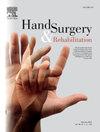Management of floating elbow injuries secondary to side swipe injury
IF 0.9
4区 医学
Q4 ORTHOPEDICS
引用次数: 0
Abstract
Floating elbow injuries, defined as simultaneous fractures of the humerus and forearm, pose challenges due to their rarity and severity. Management involves complex evaluations and interventions, with controversies in optimal timing and techniques. Side swipe injuries, typical in low-income countries with high road accidents, contribute to this injury pattern.
A retrospective study (January 2020–December 2023) involving 15 patients with side swipe-induced floating elbow injuries was conducted. Data encompassed demographics, surgical approaches, techniques, post-operative care, and outcomes.
The mean patient age was 34.7 years, predominantly male (80%). The most frequent injuries were humeral shaft fractures (53.3%). Surgical timing averaged 8.3 hours post-injury, employing varied techniques (e.g., nailing, plating) with a mean surgery duration of 2.5 hours. At 18 months follow-up, outcomes revealed satisfactory pain scores (mean: 2.7), moderate range of motion (mean: 101.3 degrees), and acceptable functional scores (MEPS: 81.7, DASH: 18.3). Complications (nonunion, malunion, delayed union, hardware failure, ossification, stiffness) affected 53.3% of patients, with revision surgeries necessary for some cases. Patient satisfaction rated as satisfied or very satisfied by 73.3% of patients.
The research aligns with previous findings, showing a higher incidence in young to middle-aged males and a predominance of right-sided injuries. The most common fracture types (humeral shaft, Monteggia) and complications (nonunion, malunion, delayed union) are consistent with existing literature. Surgical approaches and techniques varied, but nailing for humerus and plating for forearm were most common, aligning with established practices. Post-operative complications were frequent, reflecting the severity of these injuries. Despite limitations like small sample size and short follow-up, the study supports the effectiveness of timely surgery and rehabilitation in achieving satisfactory outcomes, echoing previous research. Further studies with larger cohorts and longer follow-ups are needed to validate and expand upon these findings.
The research focused on 15 cases of floating elbow injuries from side swipe accidents, outlining the challenges and treatments. Despite complexities in managing these rare injuries, surgeries tailored to fracture types showed promise. Complications like nonunion and stiffness persisted, but timely surgery and rehabilitation led to satisfactory recoveries and high patient satisfaction. Larger, longer studies are needed to refine treatments for better outcomes.
求助全文
约1分钟内获得全文
求助全文
来源期刊

Hand Surgery & Rehabilitation
Medicine-Surgery
CiteScore
1.70
自引率
27.30%
发文量
0
审稿时长
49 days
期刊介绍:
As the official publication of the French, Belgian and Swiss Societies for Surgery of the Hand, as well as of the French Society of Rehabilitation of the Hand & Upper Limb, ''Hand Surgery and Rehabilitation'' - formerly named "Chirurgie de la Main" - publishes original articles, literature reviews, technical notes, and clinical cases. It is indexed in the main international databases (including Medline). Initially a platform for French-speaking hand surgeons, the journal will now publish its articles in English to disseminate its author''s scientific findings more widely. The journal also includes a biannual supplement in French, the monograph of the French Society for Surgery of the Hand, where comprehensive reviews in the fields of hand, peripheral nerve and upper limb surgery are presented.
Organe officiel de la Société française de chirurgie de la main, de la Société française de Rééducation de la main (SFRM-GEMMSOR), de la Société suisse de chirurgie de la main et du Belgian Hand Group, indexée dans les grandes bases de données internationales (Medline, Embase, Pascal, Scopus), Hand Surgery and Rehabilitation - anciennement titrée Chirurgie de la main - publie des articles originaux, des revues de la littérature, des notes techniques, des cas clinique. Initialement plateforme d''expression francophone de la spécialité, la revue s''oriente désormais vers l''anglais pour devenir une référence scientifique et de formation de la spécialité en France et en Europe. Avec 6 publications en anglais par an, la revue comprend également un supplément biannuel, la monographie du GEM, où sont présentées en français, des mises au point complètes dans les domaines de la chirurgie de la main, des nerfs périphériques et du membre supérieur.
 求助内容:
求助内容: 应助结果提醒方式:
应助结果提醒方式:


